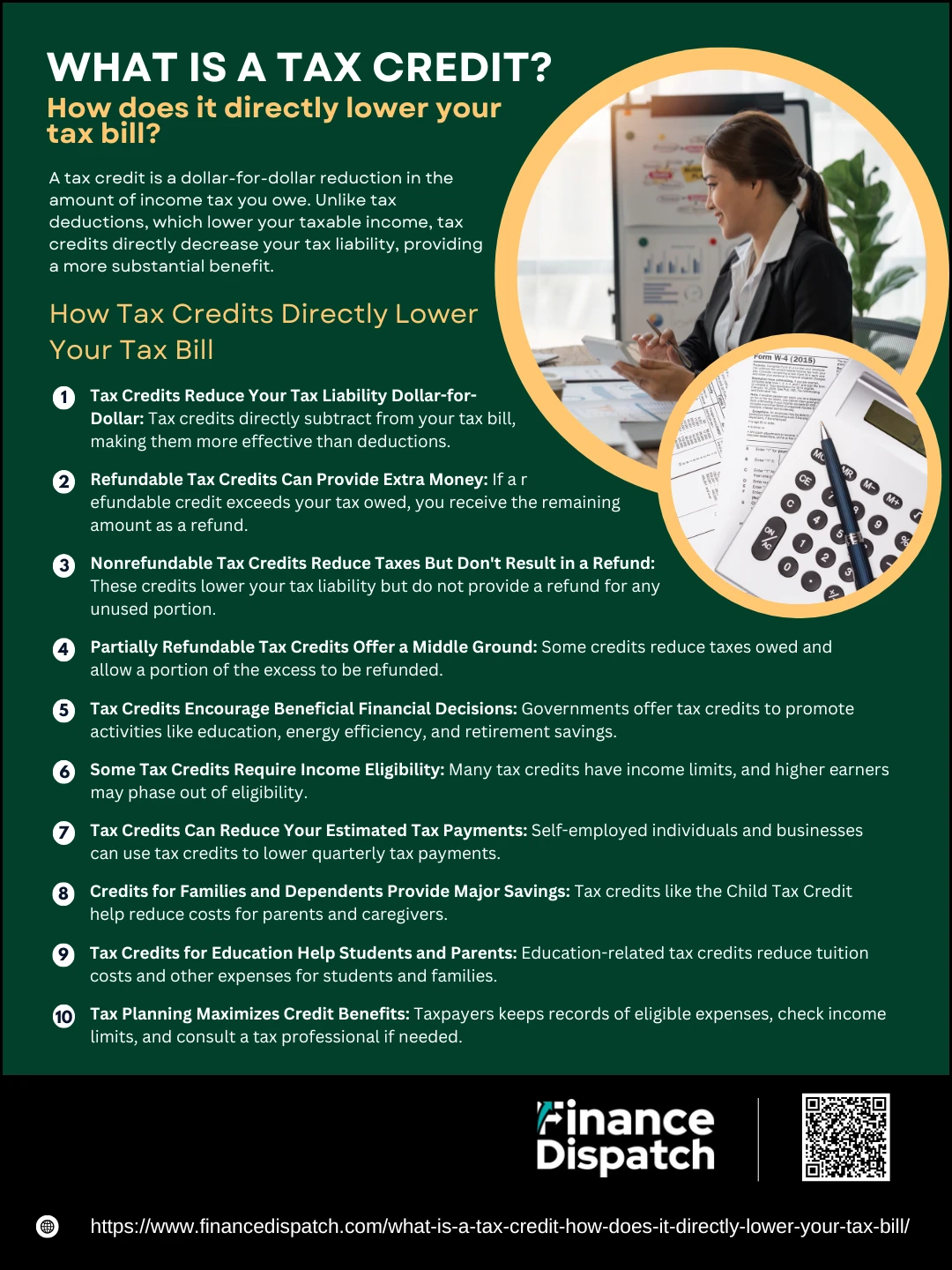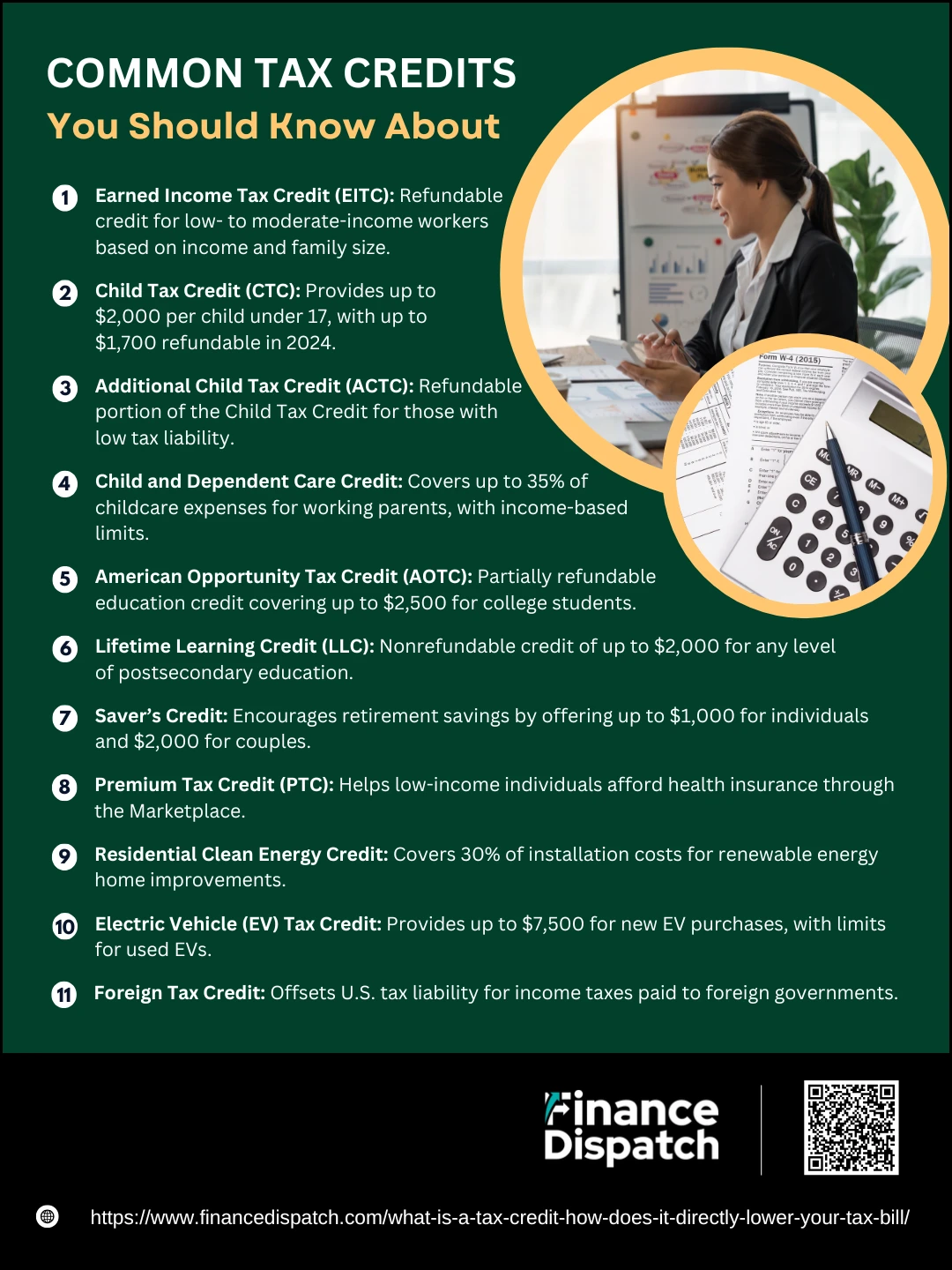When tax season arrives, every taxpayer looks for ways to reduce their tax bill. While many focus on deductions, tax credits often provide an even greater advantage. Unlike deductions, which lower your taxable income, tax credits reduce your tax liability dollar for dollar, making them a powerful tool for cutting your tax bill. Some credits can even result in a refund, putting extra money back in your pocket. But not all tax credits work the same way—some are refundable, some are nonrefundable, and others fall in between. Understanding how tax credits function and which ones you qualify for can make a significant difference in your overall tax savings. This article breaks down the different types of tax credits and explains how they can directly lower your tax bill.
What is a Tax Credit?
A tax credit is a financial benefit that directly reduces the amount of taxes you owe to the government, dollar for dollar. Unlike tax deductions, which lower your taxable income, tax credits subtract from your total tax liability, making them more valuable. For example, if you owe $3,000 in taxes and qualify for a $1,000 tax credit, your tax bill drops to $2,000. Some tax credits are even refundable, meaning if the credit exceeds your total tax liability, you could receive the remaining amount as a refund. Governments offer tax credits to incentivize specific behaviors, such as education, homeownership, energy efficiency, and supporting families with dependents. Understanding tax credits and how they work can help taxpayers maximize their savings and reduce their tax burden effectively.
 How Tax Credits Directly Lower Your Tax Bill
How Tax Credits Directly Lower Your Tax Bill
When tax season approaches, many taxpayers look for ways to reduce the amount they owe. While deductions lower taxable income, tax credits provide a direct reduction in tax liability, making them one of the most effective ways to lower your tax bill. By understanding how tax credits work and which ones you qualify for, you can significantly cut down the amount you owe—or even receive a refund. Below, we explore the key ways tax credits directly impact your tax bill and the different types of credits available.
1. Tax Credits Reduce Your Tax Liability Dollar-for-Dollar
Unlike tax deductions, which only reduce the portion of your income that is subject to taxation, tax credits subtract the full amount from your tax bill. For example, if you owe $5,000 in taxes and qualify for a $2,000 tax credit, your new tax bill becomes $3,000. This makes tax credits more powerful than deductions, especially for those in lower tax brackets who may not benefit significantly from deductions alone.
2. Refundable Tax Credits Can Provide Extra Money
Refundable tax credits not only reduce what you owe but can also result in a refund if the credit exceeds your total tax liability. For instance, if your total tax owed is $1,500 and you qualify for a $2,000 refundable tax credit, you will receive a $500 refund from the government. Refundable credits are particularly beneficial for low-income earners who may not owe much in taxes but still qualify for valuable tax benefits.
3. Nonrefundable Tax Credits Reduce Taxes But Don’t Result in a Refund
While nonrefundable tax credits also lower your tax bill, they are limited by your total tax liability. If you owe $1,500 in taxes but qualify for a $2,000 nonrefundable credit, the maximum benefit you can receive is $1,500—bringing your tax bill to zero. The remaining $500 is not refunded. These credits are still highly valuable but do not provide additional refunds beyond eliminating your tax liability.
4. Partially Refundable Tax Credits Offer a Middle Ground
Some tax credits combine elements of both refundable and nonrefundable credits. Partially refundable tax credits allow taxpayers to reduce their tax liability to zero and receive a partial refund of any remaining credit. For example, the American Opportunity Tax Credit (AOTC) provides up to $2,500 per student for college expenses, with 40% (up to $1,000) being refundable. This means even if a taxpayer does not owe any taxes, they could still receive up to $1,000 as a refund.
5. Tax Credits Encourage Beneficial Financial Decisions
Governments use tax credits to promote behaviors that benefit society, such as pursuing higher education, adopting children, using renewable energy, or saving for retirement. By offering financial incentives, tax credits help individuals and families make long-term financial decisions that also provide immediate tax savings. For instance, homeowners installing solar panels can qualify for the Residential Clean Energy Credit, which allows them to recoup a portion of their investment through a tax credit.
6. Some Tax Credits Require Income Eligibility
Many tax credits have income limits to ensure they benefit those who need them most. For example, the Earned Income Tax Credit (EITC) is specifically designed for low- to moderate-income workers. The amount of the credit varies depending on income level, filing status, and the number of dependents. Taxpayers who earn too much may phase out of certain tax credits and no longer qualify for the full amount or any portion at all.
7. Tax Credits Can Reduce Your Estimated Tax Payments
For those who pay quarterly estimated taxes, tax credits can help lower their required payments throughout the year. Business owners, freelancers, and self-employed individuals who qualify for tax credits can use them to reduce what they owe in estimated tax payments. This ensures they keep more money in their pockets throughout the year rather than overpaying taxes and waiting for a refund.
8. Credits for Families and Dependents Provide Major Savings
Tax credits specifically designed for families can significantly reduce tax liability. The Child Tax Credit (CTC), for example, provides up to $2,000 per qualifying child, with a portion of it being refundable. Parents who pay for childcare while working or looking for work may also qualify for the Child and Dependent Care Credit, further reducing their tax bill. These credits help families manage the cost of raising children while directly lowering their tax burden.
9. Tax Credits for Education Help Students and Parents
For those paying for higher education, tax credits can significantly ease the financial burden. The American Opportunity Tax Credit (AOTC) and the Lifetime Learning Credit (LLC) allow students and parents to claim part of their tuition and education expenses as a credit. These credits help offset the rising costs of education while reducing taxable income.
10. Tax Planning Maximizes Credit Benefits
Understanding tax credits and planning ahead can help taxpayers maximize their benefits. Some credits require specific documentation or timing of expenses to qualify. Taxpayers should keep records of eligible expenses, check income limits, and consult a tax professional if needed. Proper planning ensures that taxpayers take full advantage of available tax credits to reduce their tax bill effectively.
Types of Tax Credits
Tax credits come in different forms, each with unique rules on how they reduce your tax bill. Some tax credits simply lower what you owe, while others can provide a refund even if you have no tax liability. Understanding the different types of tax credits can help you determine which ones you qualify for and how they can benefit you. Below are the main categories of tax credits available to taxpayers.
- Refundable Tax Credits – These credits not only reduce your tax bill to zero but also provide a refund if the credit exceeds your total tax liability. Examples include the Earned Income Tax Credit (EITC) and the Premium Tax Credit (PTC) for health insurance coverage.
- Nonrefundable Tax Credits – These credits only reduce your tax bill up to the amount owed but do not result in a refund. If your tax liability reaches zero before using the full credit, the remaining portion is lost. Common nonrefundable credits include the Lifetime Learning Credit, Mortgage Interest Credit, and Foreign Tax Credit.
- Partially Refundable Tax Credits – These credits combine features of both refundable and nonrefundable tax credits. They first reduce your tax liability to zero, and if there is any remaining amount, a portion of it can be refunded. The Child Tax Credit (CTC) and the American Opportunity Tax Credit (AOTC) fall into this category, where a limited portion of the credit is refundable after reducing your tax bill.
 Common Tax Credits You Should Know About
Common Tax Credits You Should Know About
Tax credits play a crucial role in helping taxpayers reduce their tax burden and even receive refunds. Unlike deductions, which lower taxable income, tax credits directly subtract from the amount of tax owed, making them one of the most effective ways to save money on taxes. Some credits are designed to support families with children, while others help with education, retirement savings, home improvements, and energy efficiency. Below are some of the most valuable tax credits available to taxpayers, along with details on how they work.
1. Earned Income Tax Credit (EITC)
The Earned Income Tax Credit is a refundable credit that benefits low- to moderate-income workers. The amount you can claim depends on your income, filing status, and the number of children you have. Even if you owe no taxes, you can receive the EITC as a refund, making it one of the most helpful tax credits for working families.
2. Child Tax Credit (CTC)
Families with children under 17 may qualify for the Child Tax Credit, which provides up to $2,000 per child. This credit is partially refundable, meaning that if your tax liability is lower than the credit amount, you can still receive up to $1,700 as a refund in 2024. The CTC is phased out for higher-income earners.
3. Additional Child Tax Credit (ACTC)
If a taxpayer qualifies for the Child Tax Credit but doesn’t owe enough taxes to use the full amount, the Additional Child Tax Credit allows them to receive a refund for the unused portion. This credit is useful for lower-income taxpayers who may not have a high tax liability but still need financial support.
4. Child and Dependent Care Credit
Parents who pay for childcare so they can work or look for work can claim the Child and Dependent Care Credit. This nonrefundable credit allows taxpayers to claim up to 35% of childcare costs, with a maximum of $3,000 for one child or $6,000 for two or more children. The percentage decreases for higher-income households.
5. American Opportunity Tax Credit (AOTC)
This education-related tax credit is available for undergraduate students in their first four years of college. The AOTC covers up to $2,500 per student, with 40% (up to $1,000) refundable if the credit exceeds tax liability. Eligible expenses include tuition, fees, and course materials.
6. Lifetime Learning Credit (LLC)
Unlike the AOTC, which is limited to four years of college, the Lifetime Learning Credit can be used for any level of postsecondary education, including graduate school and professional courses. This nonrefundable credit provides up to $2,000 per tax return but cannot be refunded if it exceeds tax liability.
7. Saver’s Credit (Retirement Savings Contributions Credit)
To encourage retirement savings, the Saver’s Credit offers a tax break for low- and moderate-income earners who contribute to an IRA, 401(k), 403(b), or other qualified retirement plans. The credit amount ranges from 10% to 50% of contributions, with a maximum of $1,000 for individuals or $2,000 for married couples filing jointly.
8. Premium Tax Credit (PTC)
The Premium Tax Credit helps lower-income individuals and families afford health insurance through the Health Insurance Marketplace. The credit amount is based on household income and federal poverty level guidelines. Eligible taxpayers can choose to receive the credit in advance to reduce monthly premiums or claim it when filing taxes.
9. Residential Clean Energy Credit
Homeowners who install solar panels, wind turbines, geothermal heat pumps, or battery storage systems can claim the Residential Clean Energy Credit, which covers 30% of the installation costs. This credit encourages the use of renewable energy and helps taxpayers save money while reducing their carbon footprint.
10. Electric Vehicle (EV) Tax Credit
The federal government offers tax incentives to encourage the purchase of electric vehicles. The EV Tax Credit provides up to $7,500 for new electric vehicles that meet federal requirements. Some used EVs may also qualify for a reduced credit of up to $4,000. The availability of this credit depends on income limits and vehicle eligibility.
11. Foreign Tax Credit
If you earn income from foreign sources and pay taxes to a foreign government, you may be eligible for the Foreign Tax Credit. This credit prevents double taxation by allowing you to reduce your U.S. tax liability by the amount of foreign taxes paid. This is particularly useful for expatriates, international investors, and those with overseas business income.
Tax Credits vs. Tax Deductions
When filing your taxes, you may come across two important terms: tax credits and tax deductions. While both help reduce the amount you owe, they work in different ways. Tax deductions lower your taxable income, which in turn reduces the amount of income subject to taxation. Tax credits, on the other hand, directly reduce your tax liability dollar-for-dollar, making them more valuable in many cases. Understanding the key differences between tax credits and tax deductions can help you maximize your tax savings. The table below highlights the main differences between the two.
| Feature | Tax Credit | Tax Deduction |
| Effect on Taxes | Reduces total tax liability dollar-for-dollar | Lowers taxable income, indirectly reducing tax owed |
| Value | More valuable, as it directly cuts taxes owed | Less valuable, as savings depend on tax bracket |
| Example Calculation | If you owe $5,000 in taxes and claim a $1,000 tax credit, your tax bill becomes $4,000 | If you earn $50,000 and claim a $1,000 deduction, your taxable income reduces to $49,000 (tax savings depends on your tax rate) |
| Refundability | Some credits are refundable, meaning you can receive money back even if you owe no taxes | Deductions only reduce taxable income and cannot result in a refund |
| Examples | Child Tax Credit, Earned Income Tax Credit, American Opportunity Credit | Mortgage Interest Deduction, Student Loan Interest Deduction, Medical Expense Deduction |
| Best for | Reducing tax owed directly or increasing refunds | Lowering taxable income for potential long-term tax savings |
 How to Claim Tax Credits
How to Claim Tax Credits
Tax credits can significantly reduce your tax bill or even provide a refund, but to benefit from them, you need to know how to claim them correctly. Each tax credit has specific eligibility requirements and may require supporting documentation. Some credits are automatically applied when you file your tax return, while others need additional forms. Making sure you claim every tax credit you qualify for can help you maximize your tax savings. Below are the key steps to claim tax credits properly.
1. Determine Your Eligibility
Each tax credit has different qualifications, such as income limits, family size, education status, or dependent eligibility. Check IRS guidelines or use tax preparation software to see which credits you qualify for.
2. Gather Necessary Documentation
Some tax credits require proof of eligibility, such as W-2s, 1098-T (for education credits), childcare expense receipts, or proof of energy-efficient home upgrades. Keeping these documents organized will make the filing process easier.
3. Choose the Right Filing Status
Your filing status (Single, Married Filing Jointly, Head of Household, etc.) can affect the amount of tax credits you can claim. Some credits, like the Earned Income Tax Credit (EITC), have different income limits depending on filing status.
4. Use the Correct IRS Forms
Many tax credits require specific IRS forms to be completed, such as:
- Form 8862 – Required if you were previously denied the Earned Income Tax Credit (EITC)
- Form 2441 – Needed for claiming the Child and Dependent Care Credit
- Form 8863 – Required for education credits like the AOTC and Lifetime Learning Credit
5. File Your Taxes Electronically
Using IRS-approved e-filing software or hiring a tax professional helps ensure that all credits are properly claimed. Many software programs automatically check for tax credits based on the information provided.
6. Claim Refundable Credits for Maximum Benefit
Refundable tax credits, such as the Earned Income Tax Credit (EITC) and Premium Tax Credit (PTC), can increase your refund if the credit exceeds your tax liability. Always double-check that you are claiming the full amount you are eligible for.
7. Review Before Submitting
Mistakes in claiming tax credits can lead to delays, IRS audits, or denied claims. Carefully review your tax return to ensure all credits are applied correctly and that all supporting documents are included.
Common Mistakes to Avoid When Claiming Tax Credits
Tax credits can significantly reduce your tax bill, but making mistakes when claiming them can lead to delays, audits, or even denied credits. To maximize your benefits and avoid errors, it’s important to understand the most common pitfalls. Below are key mistakes to watch out for when filing your tax return.
- Failing to Check Eligibility – Some tax credits have income limits or specific qualifications that must be met. Always verify your eligibility before claiming a credit.
- Incorrect Filing Status – Your filing status affects the credits you qualify for. Choosing the wrong one may reduce or eliminate your credit eligibility.
- Lack of Proper Documentation – Many tax credits require proof of expenses, such as childcare receipts, tuition statements, or energy-efficient home upgrades. Without documentation, your claim may be denied.
- Overlooking Refundable Credits – Credits like the Earned Income Tax Credit (EITC) and Child Tax Credit (CTC) can increase your refund, but many taxpayers fail to claim them.
- Claiming Multiple Overlapping Credits – Some credits, like the AOTC and LLC, cannot be claimed together for the same student in the same year. Incorrect claims may trigger penalties.
- Not Using the Correct IRS Forms – Certain credits require specific IRS forms, such as Form 2441 for the Child and Dependent Care Credit or Form 5695 for Energy Credits.
- Failing to Report All Income – Not reporting side income while claiming tax credits can lead to IRS audits and penalties.
- Math Errors in Credit Calculation – Even small mistakes can result in incorrect credit amounts or IRS rejections. Using tax software can help avoid errors.
- Missing Filing Deadlines – Some refundable credits can be claimed for up to three years, but filing late may delay your refund or make you ineligible.
Conclusion
Tax credits are a powerful way to lower your tax bill and maximize your savings, but claiming them correctly requires careful attention to eligibility, documentation, and filing procedures. Understanding the different types of tax credits—whether refundable, nonrefundable, or partially refundable—can help you take full advantage of the financial benefits available. By avoiding common mistakes, keeping accurate records, and using the correct IRS forms, you can ensure a smooth tax filing process and potentially increase your refund. If you’re ever unsure about your eligibility or the best way to claim a tax credit, consulting a tax professional or using reliable tax software can help you navigate the process with confidence. In the end, knowing how to properly claim tax credits can lead to significant tax savings and a more secure financial future.



